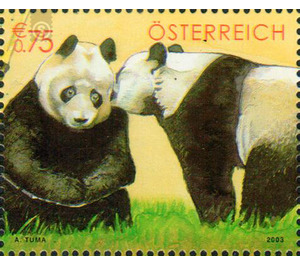panda - Austria / II. Republic of Austria 2003 - 75 Euro Cent
Theme: Animals
| Country | Austria / II. Republic of Austria |
| Issue Date | 2003 |
| Face Value | 75.00 |
| Edition Issued | 1,500,000 |
| Printing Type | Photogravure |
| Stamp Type | Commemorative |
| Item Type | Stamp |
| Chronological Issue Number | 1752 |
| Chronological Chapter | OOS-OE2 |
| SID | 58451 |
| In 30 Wishlists | |
Tiergartendirektor Helmut Pechlaner: "The charismatic Pandas are ideal ambassadors for China, they come to Austria as a gesture of friendship and will not only arouse interest in the mysterious giant empire, but also in the spirit of world conservation for the WWF (World Wide Fund for Nature Through the enthusiasm that these symbolic animals will inspire among the guests and friends of our Tiergarten, they vehemently remind us of how many fascinating creatures are threatened by extinction by us humans. " In September 2002, a contract was signed between the People's Republic of China and the Republic of Austria, which stipulates that a young panda couple born in Chinese zoos be brought to Tiergarten Schönbrunn as part of an international research and breeding program. The former elephant enclosure was redesigned for this purpose pandagerecht. The main reason for the research project is the extreme endangerment of the endangered species. Through rigorous deforestation of bamboo forests on the one hand her habitat and nutritional options were ever smaller, on the other hand, the pandas endanger themselves through their unilateral way of life themselves. For food, they prefer 90% bamboo, although her digestive tract is anything but well-adjusted to plant nutrition. They live as loners and can be multiplied in zoos practically only by artificial insemination. For 20 years, scientists with little research success have dealt with the reproductive behavior of animals. On the basis of acquired experience one hopes in Schönbrunn by observation around the clock and employment of infrared technology further information about the social and sex life, the phonetic language, the feeding, sleep and curiosity behavior of the Pandas to receive. The aim of the 10-year project is the rearing of a population that can sustain itself.Data and facts of the Great Panda: Size: 160-180 cmWeight: 80-125 kgAge: up to 25 years (in the field) Sexual maturity: about 5 Years of planting: 1-2 young (90-130 g) are born with white fur and take after approx. 1 month the typical black and white Panda-drawingInside / habitat: only in SW-China, inhabit moist, cool bamboo coniferous forestsFeatures: extreme loners, good climbers, predominantly vegetarian lifestyle - but omnivore teeth, no hibernation.More information can be found at: www.zoovienna.at


